全内反射荧光显微镜TIRFM介绍
- 格式:pdf
- 大小:1.06 MB
- 文档页数:32
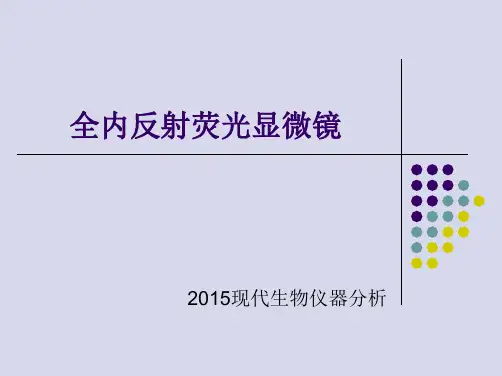
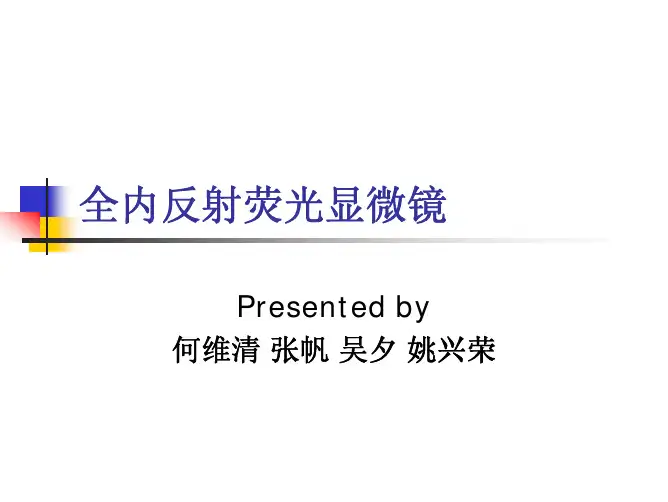
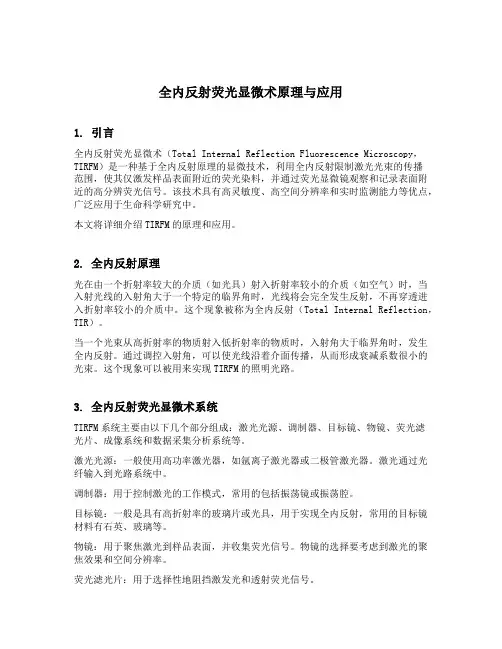
全内反射荧光显微术原理与应用1. 引言全内反射荧光显微术(Total Internal Reflection Fluorescence Microscopy,TIRFM)是一种基于全内反射原理的显微技术,利用全内反射限制激光光束的传播范围,使其仅激发样品表面附近的荧光染料,并通过荧光显微镜观察和记录表面附近的高分辨荧光信号。
该技术具有高灵敏度、高空间分辨率和实时监测能力等优点,广泛应用于生命科学研究中。
本文将详细介绍TIRFM的原理和应用。
2. 全内反射原理光在由一个折射率较大的介质(如光具)射入折射率较小的介质(如空气)时,当入射光线的入射角大于一个特定的临界角时,光线将会完全发生反射,不再穿透进入折射率较小的介质中。
这个现象被称为全内反射(Total Internal Reflection,TIR)。
当一个光束从高折射率的物质射入低折射率的物质时,入射角大于临界角时,发生全内反射。
通过调控入射角,可以使光线沿着介面传播,从而形成衰减系数很小的光束。
这个现象可以被用来实现TIRFM的照明光路。
3. 全内反射荧光显微术系统TIRFM系统主要由以下几个部分组成:激光光源、调制器、目标镜、物镜、荧光滤光片、成像系统和数据采集分析系统等。
激光光源:一般使用高功率激光器,如氩离子激光器或二极管激光器。
激光通过光纤输入到光路系统中。
调制器:用于控制激光的工作模式,常用的包括振荡镜或振荡腔。
目标镜:一般是具有高折射率的玻璃片或光具,用于实现全内反射,常用的目标镜材料有石英、玻璃等。
物镜:用于聚焦激光到样品表面,并收集荧光信号。
物镜的选择要考虑到激光的聚焦效果和空间分辨率。
荧光滤光片:用于选择性地阻挡激发光和透射荧光信号。
成像系统:一般是荧光显微镜或全内反射显微镜。
能够观察并记录样品表面的荧光信号。
数据采集分析系统:可以对观察到的荧光图像进行实时处理和分析,如图像增强、图像叠加、荧光强度计算等。
4. TIRFM原理TIRFM的原理可以通过以下步骤进行解释:1.激光从物镜聚焦到样品表面。
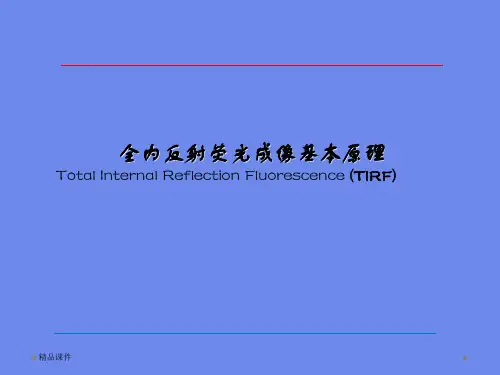
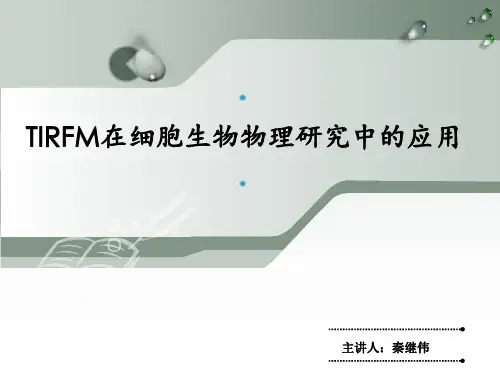
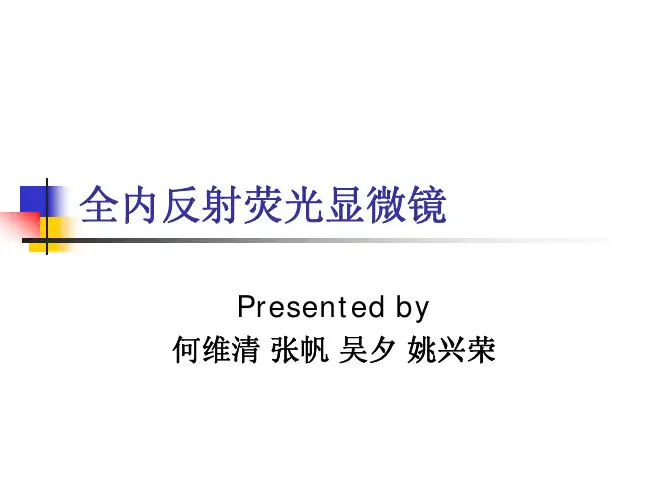
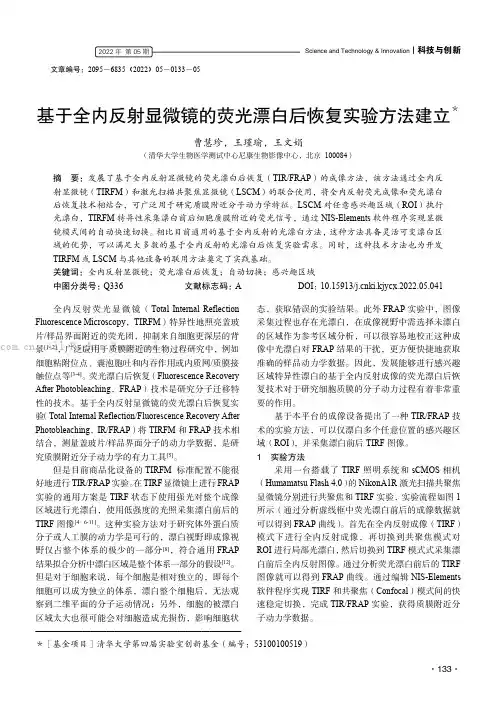
文章编号:2095-6835(2022)05-0133-05基于全内反射显微镜的荧光漂白后恢复实验方法建立*曹慧珍,王瑾瑜,王文娟(清华大学生物医学测试中心尼康生物影像中心,北京100084)摘要:发展了基于全内反射显微镜的荧光漂白后恢复(TIR/FRAP)的成像方法,该方法通过全内反射显微镜(TIRFM)和激光扫描共聚焦显微镜(LSCM)的联合使用,将全内反射荧光成像和荧光漂白后恢复技术相结合,可广泛用于研究质膜附近分子动力学特征。
LSCM对任意感兴趣区域(ROI)执行光漂白,TIRFM特异性采集漂白前后细胞质膜附近的荧光信号,通过NIS-Elements软件程序实现显微镜模式间的自动快速切换。
相比目前通用的基于全内反射的光漂白方法,这种方法具备灵活可变漂白区域的优势,可以满足大多数的基于全内反射的光漂白后恢复实验需求。
同时,这种技术方法也为开发TIRFM或LSCM与其他设备的联用方法奠定了实践基础。
关键词:全内反射显微镜;荧光漂白后恢复;自动切换;感兴趣区域中图分类号:Q336文献标志码:A DOI:10.15913/ki.kjycx.2022.05.041全内反射荧光显微镜(Total Internal Reflection Fluorescence Microscopy,TIRFM)特异性地照亮盖玻片/样品界面附近的荧光团,抑制来自细胞更深层的背景[1-2],广泛应用于质膜附近的生物过程研究中,例如细胞粘附位点、囊泡胞吐和内吞作用或内质网/质膜接触位点等[3-4]。
荧光漂白后恢复(Fluorescence Recovery After Photobleaching,FRAP)技术是研究分子迁移特性的技术。
基于全内反射显微镜的荧光漂白后恢复实验(Total Internal Reflection/Fluorescence Recovery After Photobleaching,IR/FRAP)将TIRFM和FRAP技术相结合,测量盖玻片/样品界面分子的动力学数据,是研究质膜附近分子动力学的有力工具[5]。

简述全内反射荧光显微术的原理和应用摘要:全内反射荧光显微术(Total internal reflection fluorescence microscopy TIRFM)是利用全内反射产生的消逝波激发样品,使样品表面数百纳米厚的薄层内的荧光团受到激发,再用高灵敏度和高时间分辨率的摄像机CCD来捕捉荧光并用计算机进行显像,从而实现对生物样品观测的一种新生技术。
由于消逝波特点及CCD的优势使全内反射荧光显微镜具有高信噪比和高时间分辨率,因此它在对单分子的动态观测具有很高的应用价值。
本文将对全内反射荧光显微镜的原理及应用和发展展望作一个简要的介绍。
关键词:全内反射消逝波衍射极限单分子的动态观测0 引言:人类自诞生以来不但在不断的改进自己的生产工具,同时也在不断的改进自己观察世界和了解这个世界的工具,其间显微镜的制造应改说为人类观察微观世界打开了一扇窗户,它可以称得上是人类观察认识世界上的一次革命。
此后各种新的观察工具相继问世,使人类对微观世界的认识达到了空前的高度。
但是传统的光学显微镜由于受到光瞳远场衍射效应的影响,存在分辨极限,瑞利将之归纳为R ≥0. 61λ/nsinθ,其中λ为成像光波波长, nsinθ为物透镜的数值孔径,即NA 值,因此光学显微镜空间分辨极限~250 nm。
于是人们研制了拥有点分辨率: 0.2nm的电子显微镜。
进入80年代,非光学类扫描探针显微术特别是原子力显微镜的出现更是将成像的分辨率推进到纳米的精度。
但这些显微技术在不同程度上存在系统结构复杂、成像检测环境要求苛刻等困难,尤其是不能象光学显微术那样提供重要的光学信息(如偏振态、折射率、光谱等)和进行无损伤性生物活体探测,这些因素均严格限制了它们在高分辨率细胞成像中的应用。
近年来人们开发出了一系列光学显微镜如:目前国际上公认的最有前途的单分子光学成像技术有全场相衬显微术、共焦荧光显微术,近场光学扫描显微术[1 ,2 ]和全内反射荧光显微术.其高的空间分辨率和时间分辨率、无损伤、以及对单分子活体探测的可行性,使得这些技术在分子生物学、分子化学、激光医学及纳米材料等领域有着广泛应用,并将对未来的光测技术的发展和科学的进步产生深远的影响。
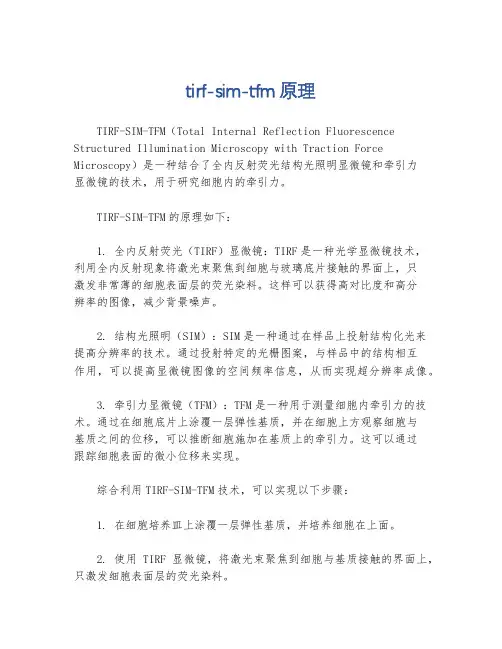
tirf-sim-tfm原理TIRF-SIM-TFM(Total Internal Reflection Fluorescence Structured Illumination Microscopy with Traction Force Microscopy)是一种结合了全内反射荧光结构光照明显微镜和牵引力显微镜的技术,用于研究细胞内的牵引力。
TIRF-SIM-TFM的原理如下:1. 全内反射荧光(TIRF)显微镜:TIRF是一种光学显微镜技术,利用全内反射现象将激光束聚焦到细胞与玻璃底片接触的界面上,只激发非常薄的细胞表面层的荧光染料。
这样可以获得高对比度和高分辨率的图像,减少背景噪声。
2. 结构光照明(SIM):SIM是一种通过在样品上投射结构化光来提高分辨率的技术。
通过投射特定的光栅图案,与样品中的结构相互作用,可以提高显微镜图像的空间频率信息,从而实现超分辨率成像。
3. 牵引力显微镜(TFM):TFM是一种用于测量细胞内牵引力的技术。
通过在细胞底片上涂覆一层弹性基质,并在细胞上方观察细胞与基质之间的位移,可以推断细胞施加在基质上的牵引力。
这可以通过跟踪细胞表面的微小位移来实现。
综合利用TIRF-SIM-TFM技术,可以实现以下步骤:1. 在细胞培养皿上涂覆一层弹性基质,并培养细胞在上面。
2. 使用TIRF显微镜,将激光束聚焦到细胞与基质接触的界面上,只激发细胞表面层的荧光染料。
3. 使用SIM技术,投射结构化光栅图案到细胞上,以提高图像的分辨率。
4. 使用TFM技术,通过跟踪细胞表面的微小位移,测量细胞施加在基质上的牵引力。
5. 结合TIRF显微镜、SIM和TFM的数据,可以获得高分辨率、高对比度的细胞图像,并且可以定量测量细胞内的牵引力。
总结起来,TIRF-SIM-TFM技术利用全内反射荧光显微镜、结构光照明和牵引力显微镜的原理,结合起来实现了高分辨率、高对比度的细胞图像,并且可以测量细胞内的牵引力。
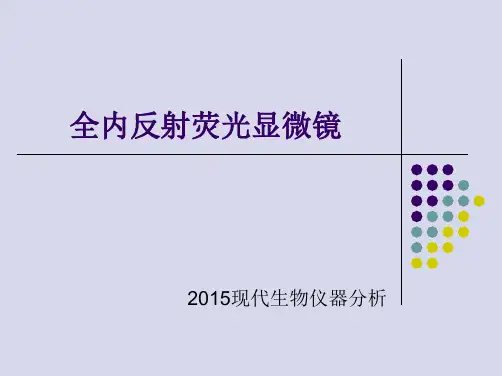
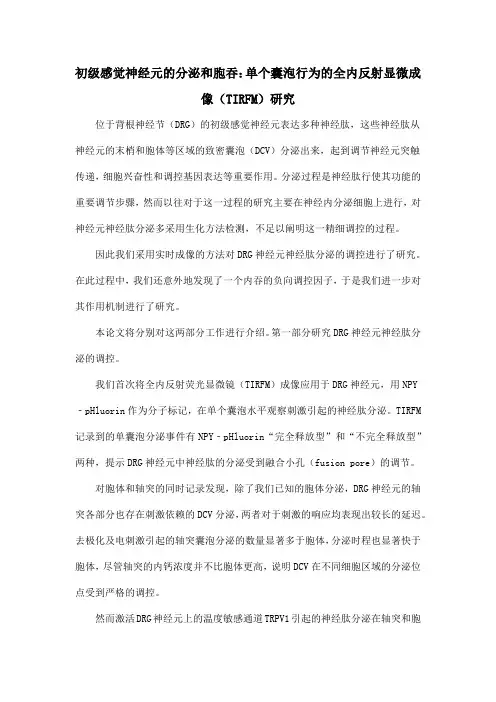
初级感觉神经元的分泌和胞吞:单个囊泡行为的全内反射显微成像(TIRFM)研究位于背根神经节(DRG)的初级感觉神经元表达多种神经肽,这些神经肽从神经元的末梢和胞体等区域的致密囊泡(DCV)分泌出来,起到调节神经元突触传递,细胞兴奋性和调控基因表达等重要作用。
分泌过程是神经肽行使其功能的重要调节步骤,然而以往对于这一过程的研究主要在神经内分泌细胞上进行,对神经元神经肽分泌多采用生化方法检测,不足以阐明这一精细调控的过程。
因此我们采用实时成像的方法对DRG神经元神经肽分泌的调控进行了研究。
在此过程中,我们还意外地发现了一个内吞的负向调控因子,于是我们进一步对其作用机制进行了研究。
本论文将分别对这两部分工作进行介绍。
第一部分研究DRG神经元神经肽分泌的调控。
我们首次将全内反射荧光显微镜(TIRFM)成像应用于DRG神经元,用NPY‐pHluorin作为分子标记,在单个囊泡水平观察刺激引起的神经肽分泌。
TIRFM 记录到的单囊泡分泌事件有NPY‐pHluorin“完全释放型”和“不完全释放型”两种,提示DRG神经元中神经肽的分泌受到融合小孔(fusion pore)的调节。
对胞体和轴突的同时记录发现,除了我们已知的胞体分泌,DRG神经元的轴突各部分也存在刺激依赖的DCV分泌,两者对于刺激的响应均表现出较长的延迟。
去极化及电刺激引起的轴突囊泡分泌的数量显著多于胞体,分泌时程也显著快于胞体,尽管轴突的内钙浓度并不比胞体更高,说明DCV在不同细胞区域的分泌位点受到严格的调控。
然而激活DRG神经元上的温度敏感通道TRPV1引起的神经肽分泌在轴突和胞体间没有明显的差异,其单个事件的动力学与去极化引起的分泌有显著的不同,有更多的不完全释放型的事件发生。
这一发现表明不同的生理刺激可以对分泌的位点和融合小孔进行调节,进而调节递质的分泌。
第二部分研究DRG神经元内吞的调控机制。
内吞过程的精确和有效的调控对于突触传递,细胞膜平衡,细胞膜表面的通道和受体的平衡等都具有重要的作用。
全内反射荧光显微镜单分子荧光能量共转移1. 引言1.1 概述本文旨在介绍全内反射荧光显微镜和单分子荧光能量共转移技术,并探讨它们在生物医学领域的应用。
全内反射荧光显微镜是一种基于全内反射现象的高分辨率显微镜,可以实现非常高的空间分辨率和极低的背景噪音,因此被广泛应用于生物体系中超分辨率成像的研究。
而单分子荧光能量共转移是一种用来研究生物体系中分子之间相互作用和结构动态变化的方法,在生命科学领域具有重要意义。
1.2 文章结构本文主要分为五个部分:引言、全内反射荧光显微镜、单分子荧光能量共转移、实验结果与讨论以及结论。
在引言部分,我们将对本篇文章进行简要介绍,并概述全内反射荧光显微镜和单分子荧光能量共转移技术的背景和意义。
随后,在接下来的几个部分,我们将逐步深入探讨这两项技术的原理、发展历程、应用领域以及实验方法与技术要点。
最后,我们将介绍相关的实验结果,并进行结果讨论与解释。
在结论部分,我们将对本文进行总结回顾,并探讨存在的问题及未来展望。
1.3 目的本文旨在全面介绍全内反射荧光显微镜和单分子荧光能量共转移技术的原理和应用,并通过实验结果与讨论来验证这两项技术在生物医学领域中的有效性。
通过本文的阐述,读者可以了解到这些重要技术在研究生物体系中起到的关键作用,并对未来发展方向有所启示。
2. 全内反射荧光显微镜部分的内容如下:2.1 原理介绍全内反射荧光显微镜(Total Internal Reflection Fluorescence Microscopy,TIRFM)是一种基于全内反射原理的高分辨率荧光显微技术。
其原理是利用高折射率物质与低折射率域之间的全内反射现象,将激发光只聚焦在非常薄的表面层上,进而使得观察对象处于极低背景的强照射区域。
相比传统荧光显微镜,TIRFM 具有更高的信噪比和更好的空间分辨率。
在TIRFM中,通过特定角度入射到玻璃-样品界面上的激发光会被全内反射。
当样品中存在荧光探针时,这些探针会受到入射激发光的刺激并发生荧光发射。
全内反射荧光显微镜(TIRFM)系统全内反射荧光显微镜TIRFM系统介绍一、全内反射荧光显微镜的原理及其在生物领域的应用全内反射荧光显微镜(Total internal reflection fluorescence microscope TIRFM)利用光从高折射率的介质进入较低折射率的介质时,如果入射角足够大时则光全部被反射而不发生折射,但是在两种介质的界面会产生衰逝波可以激发近界面100nm范围内的荧光的原理来实现对物体表面的观察。
可通过常规荧光显微镜的照明器或特殊照明器送入激发光,并对激光的入射角度进行控制,采用瞬间场激发方法以避免激发光进入探测器,在玻璃和水界面的激发光产生全内反射实现的。
为了实现全内反射,需要大的入射角,例如玻璃-水界面的入射角要大于61度。
这可以通过棱镜(prism)实现,称为prism-based TIRFM,也可通过高数值孔径的物镜实现,此时称为objective-type TIRFM。
现在商品化的全内反射荧光显微镜一般都是物镜类型的,速度快,精度高。
Wide field FL TIRFM全内反射荧光显微镜由于能实现物体表面非常薄范围内(小于100nm)荧光观察,故在某些生物领域得到广泛应用。
如以下等应用:1、细胞表面图象的观察。
如细胞膜表面结构,细胞表层的接触,膜表面动力学/蛋白质定位Fixed 3T3 纤维原细胞细胞免疫化学标记微管蛋白2、单分子观察及其操作。
肌球蛋白,肌动蛋白与Cy3标记ATP3、细胞膜表面运动。
如泡吞、泡吐现象,泡外分泌现象。
表达GFP-肌动蛋白的培养MAST 细胞正在胞饮4、细胞膜钙火花现象的观察,离子通道监视G蛋白偶联钙离子通道监视5、分子马达研究旋转的马达、细胞骨架蛋白、聚合体、G蛋白、环状蛋白、核苷酸马达RNA聚合酶反应除了在生物领域外,在化学领域等对于化学分子结构观察中也有很好的应用。
二、全内反射荧光显微镜的基本组成全内反射荧光显微镜主要由四部分组成。
Olympus Application NoteTotal internal reflection microscopy(TIRFM)is an optical technique used to observe single molecule fluorescence.Some biophysicists have used the technique for many years,while others are just beginning to explore the boundaries of this versatile mechanism for studying phenomena occurring at interfaces.Today,the technique is gaining popularity with cell biologists and neuroscientists to employ it to observe cell membrane fluorescence,in part because new membrane-specific dyes have been developed.In the past,TIRFM was difficult to perform due to the complexity of the microscope setup and the problem of achieving acceptable image brightness.A recently developed high numerical aperture microscope objective lens that improves TIRFM and makes it widely accessible is discussed in this application note.BackgroundTotal internal reflection is an optical phenomenon that can be employed to observe events occuring at boundaries.When light strikes the interface between two optical media of different refractive indices,the light incident at an angle greater than the critical angle undergoes total reflection.Beyond the angle of total reflection,the electromagnetic field of the incoming/reflected light still extends into the z direction.The strength of this field,often termed the evanescent wave,decreases exponentially,and its effects extend only a few hundred nanometers into the second medium(having the lower refractive index).That portion of the specimen within the evanescent field can be excited to emit fluorescence and consequently can be seen or recorded.This is the essence of TIRFM(see Figure1).The condition for total reflection is given by the following equation:θ(c)=sin-1(n(2)/n(1))where n(1)>n(2)where n(1)is the refractive index of the objective,n(2)is the refractive index of the specimen,andθ(c)is the critical angle.This condition is identical to that creating the evanescent wave.The key advantage of TIRFM is the shallow penetration depth of the evanescent wave. Only fluorophore molecules very near the surface of a specimen are excited to emit, creating an extremely thin optical section.Outside the evanescent field,fluorescence is minimal.This(see Figure2)effect leads to images of very high contrast having a good signal-to-noise ratio.Instrumental Approaches to TIRFMScientists have developed several TIRFM setups,of which the following types are common:(1)with illumination side prism,and(2)through the lens illumination(see Figure3).1.Setup with prism.This setup is easily accomplished,since it requires only the microscope,prism,and laser,all components that are readily available.The drawback for this setup is the requirement that the specimen be positioned between the prism and the microscope objective.2.Setup through the objective lens illumination.This setup requires that the laser be introduced through the microscope,and greatly benefits from an objective lens with a numerical aperture(NA)>1.4.The specimen must be located on the bottom surface of the cover glass.The preparation,facing away from the objective,is accessible and permits the use of other instrumentation such as micromanipulators,differential interference contrast(DIC)illuminating optics,and even a scanning probe microscope.TIRFM ObjectiveThe numerical aperture of the Olympus APO100x/NA1.65apochromatic objective lens (Olympus America Inc.,Melville,NY)greatly exceeds that of the previously highest numerical aperture objective lens,i.e.,the Plan APO100x/NA1.4(Olympus America Inc.).Living cells typically have a refractive index between1.33and1.38.To achieve total internal reflection,such a specimen must be illuminated with an numerical aperture greater than1.38(Table1).The condition is expressed in the equation listed above and following:Numerical Aperture(NA)=n•sin(θ)where NA is the numerical aperture of the objective lens,n is the refractive index,andθis the one-half the objective angular aperture.TIR Angles and Maximum Angles for Objective Lensesn(1)n(2)Total Reflection MaximumAngle A(1)(NA)Angle A(2)(NA)NA 1.4Immersion oil1.515Cells1.3865.63°(1.38)67.53°(1.40)NA 1.65Immersion liquid1.78Cells1.3850.83°(1.38)67.97°(1.65)Table1The excitation light must pass through the portion of the lens'numerical aperture cone that is greater ing a high-performance plan apochromatic1.4numerical aperture objective,a very small fraction of the lens numerical aperture(1.4–1.38= 0.02)can be utilized.While that is possible,it is very challenging to align the illuminating laser.Even with perfect alignment,increasing the light intensity is difficult because of the miniscule numerical aperture margin available.It is obvious that a lens like the APO 100x/1.65has a much greater numerical aperture latitude(1.65–1.38=0.27),making it easier to introduce the excitation light through the objective lens exit pupil(Figure4 and Table1).In order to maintain the numerical aperture and achieve the image quality the objective is capable of,a special immersion medium of high refractive index(immersion liquid [Cargille Laboratories,Cedar Grove,NJ]:n(d)=1.78)must be used.(This is volatile and should be handled using Good Laboratory Industrial Practice).Also,the cover glass must have a high refractive index(n(d)=1.788;available fromOlympus America Inc.),however its very low volume of manufacture makes it comparatively costly.Additional ApplicationsThe lens has benefits for other applications as well.Good near-infrared transmission makes it useful for laser trapping(transmission at1064nanometers equals60percent).A specialized prism is available for super-resolution DIC and capitalizes on the objective lens numerical aperture.Fluorescence microscopy gains a more than30percent intensity advantage over the 100x/1.4numerical aperture objective.The techniques of TIRFM,DIC,and standard fluorescence microscopy can also be combined.ConfigurationThe authors'setup for TIRFM(details given in Tables2and3)uses the IX70inverted microscope(Olympus America Inc.)equipped to include the right-side camera port and IX laser port.The laser is located to the left of the microscope.Through the 180-millimeter laser port tube lens,a laser is projected into the exit pupil of the illuminating/imaging lens(see Figure5).As a light source,a low-noise20-milliwatt solid-state laser,emitting at532nanometers (Crysta Laser,Reno,Nevada),was used.Argon,helium-neon,and krypton lasers can also be used,either coupled directly or via optical fiber.The limited image intensity achieved with TIRFM suggests the use of a cooled monochrome camera such as the OLY-110,OLYMPIX2000,or MagnaFire(Olympus America Inc.).Sample Setup for IX70TIRFM(All products from Olympus America Inc.)Cat.#Description QuantityIX701F IX701F:inverted scope stand1IX-PR100R Right-side camera port modification15-UR480I7-DIP/RFAC:laser port B15-UR481Tube lens for laser port B12-U1002WH10x:eyepiece12-U100H2WH10xH-2:eyepiece15-UL210IX-ILL100LB:illumination pillar18-C406Halogen lamp12V/100W16-U210IX-LWUCD:long-working-distance(WD)condenser1U-P230IX-LWPO:polarizer1U-CD436IX-DPO100:DIC prism for APO100X/NA1.651U-P100U-DICT:DIC prism1U-P235IX-AN:analyzer15-UE400IX-RFA/S:fluorescence illuminator19-U72332ND25:25%transmission filter for FL15-UL593IX-UCLHG:collector lens for FL15-UL500U-ULH:lamphouse for FL15-UL515U-ULS100HG:lamp socket for FL15-LB256BH2-RFL-T3:power supply for Hg18-B192HBO103:100-W Hg lamp1 3-U145U-B190CT:Binocular with centering telscope14-U220IX-SVL:left-side handle stage1 U-V411U-CMT:C-mount adapter1 U-V420IX-TVAD:adapter1 1-UB823UPLAPO10x/NA0.4,WD3.1mm1 1-UB935PLAPO100x/NA1.4,WD0.1mm1 1-UB615APO100x/NA1.65,WD0.1mm1 UYCP-11Power cable19-U990Cover glass forAPO100x/NA1.655-piece set1Table2Recommended Third-Party Hardware/MaterialsCat.#Description Quantity168MX1780Immersion liquid:n(d)=1.78,.25oz.(Cargille Laboratories)(McCrone Associates)1GCL-025-L 532-nm25-mW laser(Crysta Laser)107BSF013Damped stable rod with two mirrors(Melles Criot)1H61386Zoom beam expander10-20x(Edmund Scientific)1Table3Imaging experimentsOn a cover glass,a specimen consisting of0.2-µm fluorescent beads and tetra methyl rhodamine isothiocyanate(TRITC)stained cheek cells were prepared,and the fluorescence image and the TIRFM image were compared(see Figures6and7).In fluorescence mode,having focused on the beads,the bead fluorescence is very difficult to distinguish because of the obscuring background fluorescence from the cheek cells.In TIRFM imaging mode,the image contrast is dramatically high,and beads can be observed easily.Only the near field(a few hundred nanometers below the specimen side coverslip surface)is excited.The cheek cells are out of reach of the evanescent wave and do not contribute to the fluorescence image.In other experiments,DiI-stained Hela cells and neurons were observed,and fluorescence and TIRFM were compared.In each case, TIRFM permitted very high contrast observation of the cell surface(Figures8and9).ConclusionsThe APO100x/1.65is a very high resolution objective that is offered at a time wheninterest in TIRFM is increasing.The high numerical aperture of the objective,convenient IX70configuration,and relative economy of solid-state lasers bring TIRFM into the mainstream of microscopy imaging techniques.Application of the objective in conjunction with TIRFM offers new and exciting investigative opportunities to the research community.。